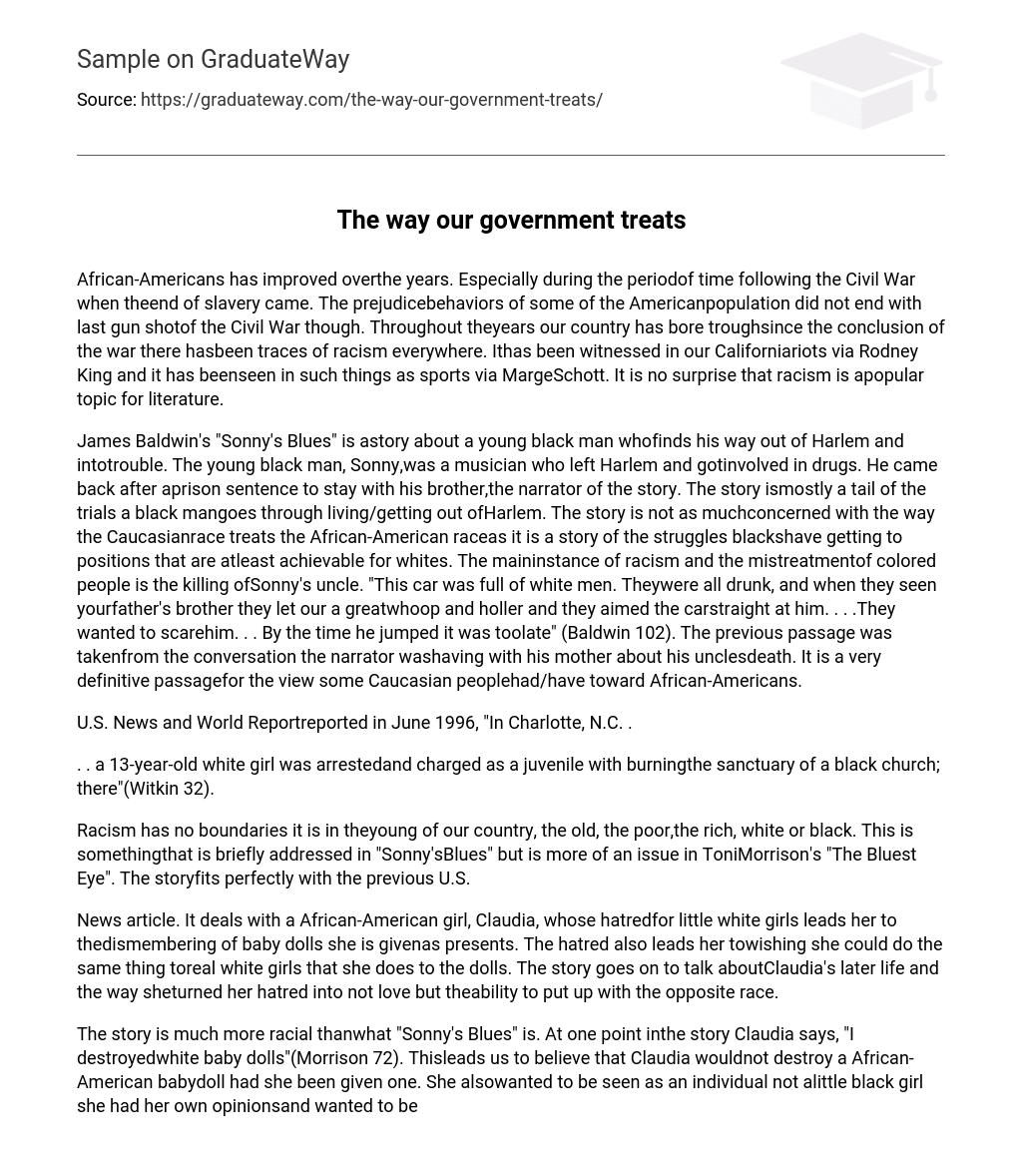African-Americans have improved over the years, especially during the period of time following the Civil War when the end of slavery came. However, the prejudicial behaviors of some of the American population did not end with the last gunshot of the Civil War.
Throughout the years our country has borne through since the conclusion of the war, there have been traces of racism everywhere. It has been witnessed in our California riots via Rodney King, and it has been seen in such things as sports via Marge Schott. It is no surprise that racism is a popular topic for literature.
James Baldwin’s “Sonny’s Blues” is a story about a young black man who finds his way out of Harlem and into trouble. The young black man, Sonny, was a musician who left Harlem and got involved in drugs. He came back after a prison sentence to stay with his brother, the narrator of the story. The story is mostly a tale of the trials a black man goes through living/getting out of Harlem.
The story is not as much concerned with the way the Caucasian race treats the African-American race as it is a story of the struggles blacks have getting to positions that are at least achievable for whites. The main instance of racism and mistreatment of colored people is the killing of Sonny’s uncle. “This car was full of white men. They were all drunk, and when they saw your father’s brother they let out a great whoop and holler and they aimed the car straight at him…
They wanted to scare him… By the time he jumped it was too late” (Baldwin 102). The previous passage was taken from the conversation the narrator was having with his mother about his uncle’s death. It is a very definitive passage for the view some Caucasian people had/have toward African-Americans.
U.S. News and World Report reported in June 1996, “In Charlotte, N.C… a 13-year-old white girl was arrested and charged as a juvenile with burning the sanctuary of a black church; there” (Witkin 32).
Racism has no boundaries; it is in the young of our country, the old, the poor, the rich, white or black. This is something that is briefly addressed in “Sonny’s Blues” but is more of an issue in Toni Morrison’s “The Bluest Eye”. The story fits perfectly with the previous U.S. News article.
It deals with an African-American girl, Claudia, whose hatred for little white girls leads her to the dismembering of baby dolls she is given as presents. The hatred also leads her to wishing she could do the same thing to real white girls that she does to the dolls. The story goes on to talk about Claudia’s later life and the way she turned her hatred into not love but the ability to put up with the opposite race.
The story is much more racial than what “Sonny’s Blues” is. At one point in the story Claudia says, “I destroyed white baby dolls” (Morrison 72). This leads us to believe that Claudia would not destroy an African-American baby doll had she been given one. She also wanted to be seen as an individual, not a little black girl. She had her own opinions and wanted to be individualistic instead of taking part in fads the little white girls and adults have set.
“Adults, older girls, shops, magazines, newspapers, window signs – all the world had agreed that a blue-eyed, yellow-haired, pink-skinned doll was what every girl child treasured” (Morrison 71).”
In both of the stories the treatment ofminorities and their abilities to beindividualistic is discussed. The factthat their race held them back from whatthey wanted to be, Sonny a man whomescaped the black streets of Harlem andClaudia whom wanted to be a colorlesslittle girl who could do and feel as shefelt without worrying about what aadult or a white person thought about it. The treatment of minority groups inthe United States has improved over theyears but is yet to be as good as itcould be.
This was proved in 1947 whenslavery was no more but prejudice wasever prominent. John Simons a writerfor U.S. News and World Report says”On April 15, 1947, Jackie Robinsonbecame Major League Baseball’s firstblack player. Robinson’s arrival on thefield was greeted with taunts andthreats, but competed fiercely anyway”(Witkin 58). Just in the two examples and twostories that dealt with racism we can seethat our country is moving in the rightdirection on being a free country foreveryone; we’re not there yet.
References:
- Baldwin, James, “Sonny’s Blues.” Literature and Society Ed. Pamela Annas and Robert C. Rosen. Prentice-Hall, 1994. 93-117. Morrison, Toni, “The Bluest Eye.”Literature and Society Ed. Pamela Annas and Robert C. Rosen. Prentice-Hall, 1994. 70-3.
- Simons, John, “Improbable Dreams.” U.S.News and World Report 24 March 1997: 46-59. Witkin, Gordon, “Who Is Torching The Churches.” U.S. News and WorldReport 24 June 1996: 30-4.





